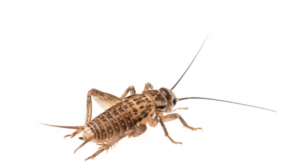Exploring Cricket Protein as a Sustainable Protein Source
 There are lots of protein sources out there, from beef cattle to chickens to dairy, tofu, and nuts, but one tiny contender is making waves: crickets. Yes, crickets. The little bugs that chirp. These musical insects might just be the next big thing in sustainable nutrition. But before you start swapping out chicken breast for cricket flour (or before your hit the Back button in disgust), let’s take a closer look at the potential benefits and drawbacks of this new food source (well, new to some parts of the world).
There are lots of protein sources out there, from beef cattle to chickens to dairy, tofu, and nuts, but one tiny contender is making waves: crickets. Yes, crickets. The little bugs that chirp. These musical insects might just be the next big thing in sustainable nutrition. But before you start swapping out chicken breast for cricket flour (or before your hit the Back button in disgust), let’s take a closer look at the potential benefits and drawbacks of this new food source (well, new to some parts of the world).
Lots of Potential in a Tiny Package
In many parts of the world, humans have been dining on insects for centuries or even thousands of years. In fact, over 2 billion people rely on insects as part of their protein intake. So why not explore the possibility of adding them to our menus in the West?
Interest in entomophagy, or insect consumption, has surged in recent years, and this newfound curiosity isn’t without merit. Crickets offer several enticing advantages.
They are incredibly efficient protein producers. Pound for pound, little crickets pack a seriously huge protein punch—about 65% protein content, which is about double that of skinless chicken breast. When milled into a powder, cricket protein can contain as much as 77% protein per pound.
Crickets are also rich in essential nutrients like B vitamins, calcium, iron, magnesium, and zinc. They even contain healthy fats and fiber, a rarity among most meat sources. Plus, cricket protein is generally more digestible than meat, thanks to chitin, an insoluble fiber found in their exoskeletons, which promotes gut health and reduces inflammation.
From an environmental standpoint, crickets also come out on top. Unlike resource-intensive livestock farming, cricket farming is remarkably efficient. That makes sense: they’re so small! Insects require significantly less feed to produce protein compared to traditional livestock. For instance, crickets need just 2 kilograms of feed for every 1 kilogram of body weight gain, whereas cattle require a staggering 12 times more feed for the same protein output.
In countries like Laos, Thailand, and Vietnam, cricket farming has gained traction due to its low carbon footprint and the minimal amount of resources required. Many farmers cultivate crickets in backyard settings, making it an accessible and eco-friendly protein source.
What’s the Catch?
There isn’t necessarily a catch, but before you hop onto the cricketwagon, it’s essential to weigh the potential downsides.
A significant concern for some experts is the lack of comprehensive research on cricket protein’s long-term health effects for populations who don’t normally consume it. While studies suggest various health benefits, including improved gut health and nutrient absorption, more research is needed to fully understand cricket protein’s impact on human health.
The cricket industry also remains largely unregulated, raising questions about product quality and safety. Cricket protein is a supplement in the United States, which means it doesn’t have as much FDA oversight as it normally would have. Without this oversight, consumers face uncertainties regarding the purity and composition of cricket protein products. Concerns about potential allergens and parasites also present additional challenges.
Recent studies have also cast doubt on the scalability and efficiency of farming these little critters. Despite their reputation for efficiency, crickets fed certain diets exhibit poor biomass accumulation and feed-conversion rates. In some cases, crickets have experienced significant mortality rates before becoming big enough to harvest. This naturally raises questions about their viability as a mainstream protein source.
Cricket or Kick It?
Ultimately, consumers must make the decision whether or not to incorporate cricket protein into their diets. While cricket flour and protein powder offer a sustainable and nutrient-rich alternative to traditional protein sources, it’s important to know that some problems still need to be resolved.
Are crickets the protein of the future or just a passing trend? Should we just keep eating chickens? Or should we just get our protein from plants? Only time will tell. In the meantime, adventurous and eccentric eaters may find excitement in exploring the culinary possibilities of these tiny yet mighty bugs.
